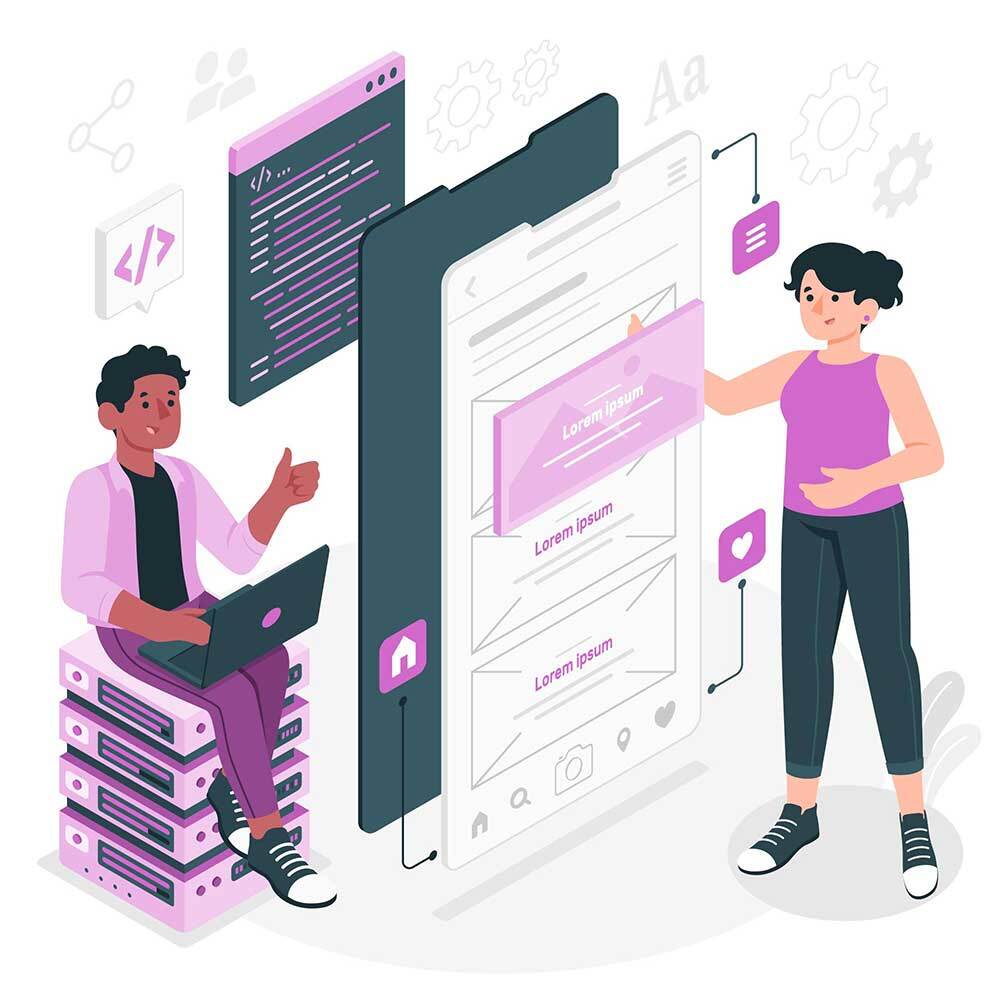In an era where smartphones have become extensions of ourselves, mobile applications have become the lifeblood of our digital experiences. Whether ordering your morning coffee, catching up on the latest news, or staying connected with friends and family, mobile apps have seamlessly woven into the fabric of our daily lives. But have you ever wondered how these apps, compatible with iOS and Android, come to fruition? Enter the world of hybrid mobile applications; a powerful and versatile solution that marries the best of both native and web development.
In this blog post, we’ll journey to demystify hybrid mobile applications. We’ll uncover what exactly makes them tick, explore the technologies behind their creation, and shed light on why businesses and developers alike are increasingly turning to hybrid approaches.
What is a Hybrid Application?
A hybrid application, also known as a hybrid app, is a type of mobile application that combines elements of both native and web applications. It is designed to work on multiple platforms, such as iOS and Android, using a single codebase. Hybrid apps are created using web technologies like HTML, CSS, and JavaScript, and then wrapped in a native container that allows them to be installed and run on a user’s device, just like a native app.

What are the characteristics of hybrid Mobile applications?
Hybrid applications offer a range of features that make them a popular choice for mobile app development. These features combine elements of both web and native apps, providing a versatile solution for businesses and developers. Here are some key features of hybrid applications:

Cross-Platform Compatibility
Hybrid apps are developed using a single codebase that can run on multiple platforms, such as iOS, Android, and sometimes even web browsers. Cross-platform compatibility cuts down on costs and development time.
Web Technologies
Hybrid apps are built using standard web technologies like HTML, CSS, and JavaScript. Developers with web development skills can leverage their expertise to create mobile apps.
Native Container
Hybrid apps are wrapped in a native container that allows them to be installed and run on a user’s device. This container provides access to device features and ensures the app can be distributed through app stores.
Access to Device Features
Hybrid apps can access native device features, such as the camera, GPS, contacts, accelerometer, and more, through plugins or APIs. This enables developers to incorporate device-specific functionality into their apps.
Cross-Platform Development Tools
Various frameworks and tools, such as Apache Cordova (formerly PhoneGap), Ionic, React Native, and Xamarin, facilitate the development of hybrid apps. These tools provide pre-built components, libraries, and plugins to streamline development.
Offline Functionality
Hybrid apps can store data locally and offer offline functionality, similar to native apps. They can cache content and synchronize data when a network connection is available.
Faster Development and Updates
Since hybrid apps share a single codebase across platforms, updates and changes can be implemented more quickly compared to maintaining separate native codebases. This speeds up development cycles and allows for faster feature rollouts.
Cost-Effective Development
Developing a hybrid app can be more cost-effective than creating separate native apps for each platform. Code reuse and a single development team can lead to significant cost savings.
Wide Audience Reach
Hybrid apps can reach a broad audience since they are compatible with multiple platforms. This can be especially advantageous for businesses targeting a diverse user base.
App Store Distribution
Hybrid apps can be published on app stores, just like native apps, making them accessible to users through popular app marketplaces.
It’s important to note that while hybrid apps offer many advantages, they may not provide the same level of performance or access to all device features as fully native apps. The choice between hybrid and native development depends on the specific requirements and goals of the project.
WebView Component
Hybrid apps typically use a WebView component to display web content within the native app shell. This WebView can render HTML, CSS, and JavaScript, enabling the integration of web content seamlessly.
Simplified Maintenance
Maintaining a single codebase for hybrid apps simplifies ongoing maintenance and bug fixes, reducing the effort required to keep the app up to date.
Difference between Native vs Hybrid Mobile Applications
Native applications are built specifically for a single platform, such as iOS or Android, using platform-specific programming languages and tools. This approach allows for optimal performance, a seamless user experience consistent with the platform’s design guidelines, and direct access to device features. Native apps can fully leverage the hardware capabilities of the device and are typically distributed through platform-specific app stores, which can enhance visibility and trust among users. However, developing separate native apps for different platforms can be time-consuming and costly, requiring developers with expertise in the specific languages and tools for each platform.
On the other hand, hybrid applications are developed using web technologies like HTML, CSS, and JavaScript. They offer a cost-effective solution for cross-platform development, as much of the code can be shared across different platforms. While hybrid apps have made significant strides in performance and user experience through frameworks like React Native and Flutter, they may not match the performance and native feel of their native counterparts. Access to device features often relies on third-party plugins, which may not be as comprehensive or up-to-date as native options. Hybrid apps can be distributed through app stores but may face additional scrutiny due to potential performance and user experience issues. The choice between native and hybrid development depends on factors like project requirements, budget, timeline, and performance needs, and developers should carefully weigh these considerations when making a decision.

Hybrid App: How does it work?
Hybrid apps are typically built using web technologies such as HTML, CSS, and JavaScript, and they run inside a native container. Here’s how a hybrid application works:
Hybrid Mobile App Development
Hybrid app development begins with writing the core application code using web technologies. This codebase includes the User Interface (UI), business logic, and application features. Frameworks and tools like Apache Cordova (formerly PhoneGap), Ionic, and React Native can be used to facilitate hybrid app development. These frameworks provide access to native device capabilities through JavaScript APIs.

Compilation and Packaging
Once the core application code is ready, it is wrapped or packaged within a native container for the target mobile platform e.g., Android or iOS. The native container is essentially a web browser component (WebView) that can display web content within a native app.
Deployment
The compiled hybrid app can be distributed through app stores e.g., Google Play Store for Android and Apple App Store for iOS just like native apps. On their smartphones, users download and install the software.
User Interaction
Users interact with the hybrid app as they would with a native app, unaware that the majority of the UI is powered by web technologies. User inputs and interactions trigger JavaScript functions and logic, updating the app’s behavior and UI dynamically.
Offline Support
Some hybrid apps are designed to work offline by caching resources and data locally.
Data synchronization and offline capabilities are implemented using technologies like Service Workers or other storage mechanisms.
Updates
When updates are needed, developers make changes to the web-based code and package a new version of the app. Users receive updates through their app store, just like native apps.
Conclusion
In conclusion, hybrid mobile applications have emerged as a versatile and cost-effective solution for businesses and developers looking to reach a broad audience across different platforms. Hybrid apps fill the gap between native and web applications by utilizing web technologies like HTML, CSS, and JavaScript. They offer the advantage of code reuse, making it easier and more affordable to maintain an app for both iOS and Android. However, it’s essential to be mindful of the potential trade-offs, such as slightly reduced performance and challenges in achieving a truly native look and feel.
In today’s rapidly evolving tech landscape, hybrid applications have emerged as a powerful solution to bridge the gap between native and web-based mobile apps. And at Fegno Technologies, we take immense pride in being at the forefront of delivering the best-in-class services in hybrid application development.
Our journey in the realm of hybrid app development has been marked by innovation, dedication, and a relentless pursuit of excellence. We understand that the future of mobile app development lies in crafting solutions that seamlessly blend the performance of native apps with the versatility of web apps. This is where our expertise shines.
So, if you’re looking for a partner who can turn your hybrid app dreams into reality, look no further. Fegno Technologies is your trusted ally, dedicated to providing the best service in hybrid mobile application development.

Looking for an expert Hybrid Mobile app development company?
Get One Step Ahead Now !
Fegno technologies is a hybrid mobile app development company. Using state-of-the-art technology and with a global presence, we provide applications that are way ahead of their time.


 Schedule An Appointment
Schedule An Appointment